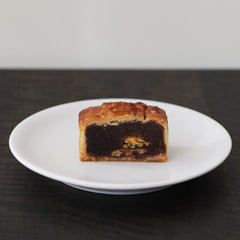
Mooncakes and Tea Pairing
Mooncakes in Chinese Culture
Mid-Autumn Festival (中秋節), also known as the Lantern or Mooncake Festival, is celebrated on the 15th day of the 8th month on the lunar calendar. It typically corresponds to mid-September to early October on the western calendar.
On this day, the Chinese believes that the moon is at its brightest and fullest, coinciding with harvest time in the middle of Autumn. The festival celebrates family reunion while giving thanks to nature as autumn harvest comes to an end.
Traditionally, family gathers during Mid-Autumn festival to enjoy mooncakes and share pots of tea together while gazing at the moon. The moon at its biggest and roundest on this day, signifies a harmonious family reunion.
Mooncake, a rich pastry typically filled with sweet-bean or lotus-seed paste, are traditionally eaten during the festival along with tea, Osmanthus wine and pomelo citrus, shared amongst friends and family. Lanterns of all size and shapes, are carried and displayed - as beacons to light the way to prosperity and good luck.



Pairing Tea with Mooncakes
Tea is typically the beverage of choice to complement mooncakes. With the rainbow of options out there for mooncakes fillings, we thought we would suggest a few tea pairings to make your Mid-Autumn celebration more delicious.
We paired our teas with classic mooncake fillings for this exercise in order to keep things manageable.
Taiwanese Mooncake – sweetened mung bean paste


Gently sweetened mung bean paste with a soft flaky shell, this style of mooncake is our favorite for obvious reasons: it's a Taiwanese classic and our childhood memory. A lightly floral and buttery oolong brings out the earthiness of the mung bean. Together, the soft and gentle aroma from the tea makes the filling creamier and more elegant in flavor.
Tea pairing: #2028, Mount Pyrus, Baozhong
White Lotus Mooncake


This is arguably the most popular filling in the world of mooncakes. It’s gently sweet and creamy in texture. We found it to be most delicious with a soft textured tea that is aromatic and has a beautiful finish. Any unroasted high elevation grown teas from Taiwan are good options here. We also like the white florals and creamy quality of the Yilan milk oolong.
Tea pairing: Mount Qilai, Mount Pyrus, Graceful Hill
Green Tea Mooncake


We had to include the green tea filling. Believe it when we say a green or greener style oolong pairing brings out the grassy vibrancy of the green tea filling. Texturally this filling is similar to the white lotus, so we are sticking with lighter bodied tea for this pairing.
Tea pairing: Canyon Green, Baozhong, Mount Qilai
Red Bean Mooncake


Red bean makes common appearances in Asian desserts, mooncakes included. The gentle tanginess and full flavor of the red bean pairs wonderfully with higher oxidized oolongs or full-bodied black teas. We prefer something unroasted and flower forward or honey scented to bring forward a secondary dimension.
Tea pairing: Oriental Beauty, Blossom Dearie, Crimson Grace
Filling with Egg Yolk Mooncake


Salted egg yolk is one of the best inventions in the Chinese culinary evolution, particularly when it is part of a dessert. A little savory and a little sweet, one balances out the other. To stand up to the wonderous duo of sweet and salty, we prefer roasted oolongs as a fun counterpart to the eggy savory-ness. Anything from a light roast to your darkest smoky tea could be interesting here, but we prefer medium to dark roast.
Tea pairing: Buddha’s Hand Roast, Ruby Brew
In Conclusion
Pairing tea to your celebratory dessert is a fun and harmless activity (vs. wine or liquor pairing). We did this exercise partially because it was a lovely activity to do after dinner. It was delightful to see how each tea changes the flavor of the mooncake, some for the better and some actually for the worse. We encourage you to try all the different teas in your cabinet.
Image Credits: Jennifer Woodard Maderazo from Barcelona, Spain - Flickr, CC BY 2.0, https://commons.wikimedia.org/w/index.php?curid=89336584
